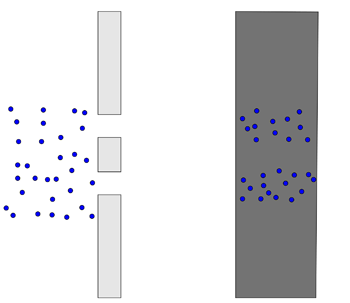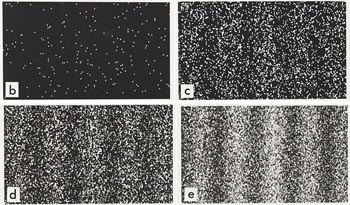The Double-Slits Experiment and Quantum Physics
Throughout the physics course this year, we have been learning about mechanics---Newtonian mechanics, specifically. Also known as classical mechanics, this branch of physics describes the macroscopic world, including objects we see every day on Earth. When we try to determine how long it takes for a block to slide down a ramp or what velocity is needed to maintain a satellite in space, for example, we use Newtonian mechanics. However, classical mechanics des not apply in every scenario. When describing objects with extraordinary velocity or immense mass, for example, theory of relativity is necessary. When describing microscopic objects at atomic level, on the other hand, quantum mechanics becomes useful. One important concept in quantum mechanics is wave-particle duality, which says that a particle sometimes behaves like a wave while sometimes behaves like a particle. This concept is demonstrated through a famous experiment---double slits experiment.
This experiment shows the weirdness of the microscopic world. The basic setup involves a source of particles (a light source in the case of photon), a sheet with two slits, and a screen on which the particles are projected. If particles (just like marbles) pass through the sheet with two slits, the ones that pass through the sheet will be projected on the screen, shown as two lines each corresponding to a slit.
 A wave (just like water waves), however, behaves differently. When a wave passes through two slits, they create an interference pattern. The waves interact with each other. Sometimes they cancel out, which is shown as strips of black region in the sketch below. Sometimes they add up with each other, which is shown as bright strips below. Thus, when a wave passes through the two slits, they are projected as an interference pattern of bands of strips. An easy experiment with this double-slit setup on water can show this property of waves.
A wave (just like water waves), however, behaves differently. When a wave passes through two slits, they create an interference pattern. The waves interact with each other. Sometimes they cancel out, which is shown as strips of black region in the sketch below. Sometimes they add up with each other, which is shown as bright strips below. Thus, when a wave passes through the two slits, they are projected as an interference pattern of bands of strips. An easy experiment with this double-slit setup on water can show this property of waves.
Thus, the double-slit experiment can show if the source, such as light, behaves like wave or particle. If light behaves like a wave, the interference pattern should be observed on the screen, while if light behaves like a particle, there should only be two bands of strips.
It turns out that light indeed behaves like a wave: when a beam of light passes through the two slits, the light waves interfere with each other and the screen indeed shows an interference pattern.
:quality(75)/curiosity-data.s3.amazonaws.com/images/content/landscape/standard/ea575553-3835-48cd-fa00-829566376372.png)
In fact, this result is not only true for light, which consists of particles called photons, but true for beams of atoms and even molecules as well. Since we all know that light consists of photon particles and beams of atoms are apparently made up of particles (atoms), maybe microscopic particles only behave as if they were waves when they are present in large amount? To test how individual particles behave, scientists conduct the double-slit experiment again, but this time not by shooting a light beam, but by firing individual photon particles one at a time.
Since now only one particle passes through the two slits each time, they cannot interfere with each other, so they should behave just like marbles, showing only two bands on the screen, right? Like this?
That is intuitive, but...wrong. Let's say particles, such as electrons, are fired one at a time. After some time, miraculously, an interference pattern still appears! The following is an actual double-slits experiment in which electrons are fired one at a time.

As more electrons are fired, an interference pattern begins to emerge. It seems each individual particle simply knows where to go even though it is traveling alone? How does that work? Why does an individual particle still behave like a wave?
It just seems that, miraculously, each one particle passes through both slits at the same time and interacts with itself, creating an interference pattern??
Now, scientists want to know through exactly which of the two slots does each photon particle pass through, and things gets even weirder. Scientists install a measuring device near the slits to see through which slit does each particle pass through. A nice but kinda creepy video online uses an eye to represent the measuring device so I took a screenshot of that.
The pictures and diagrams used in this blog are adapted from the following references.
References:
https://curiosity.com/topics/the-double-slit-experiment-cracked-reality-wide-open-curiosity/
https://plus.maths.org/content/physics-minute-double-slit-experiment-0
https://www.youtube.com/watch?v=swD--0MMVN8
https://www.clerro.com/mobile/guide/491/quantum-superposition-and-entanglement-explained
This experiment shows the weirdness of the microscopic world. The basic setup involves a source of particles (a light source in the case of photon), a sheet with two slits, and a screen on which the particles are projected. If particles (just like marbles) pass through the sheet with two slits, the ones that pass through the sheet will be projected on the screen, shown as two lines each corresponding to a slit.

Thus, the double-slit experiment can show if the source, such as light, behaves like wave or particle. If light behaves like a wave, the interference pattern should be observed on the screen, while if light behaves like a particle, there should only be two bands of strips.
It turns out that light indeed behaves like a wave: when a beam of light passes through the two slits, the light waves interfere with each other and the screen indeed shows an interference pattern.
:quality(75)/curiosity-data.s3.amazonaws.com/images/content/landscape/standard/ea575553-3835-48cd-fa00-829566376372.png)
In fact, this result is not only true for light, which consists of particles called photons, but true for beams of atoms and even molecules as well. Since we all know that light consists of photon particles and beams of atoms are apparently made up of particles (atoms), maybe microscopic particles only behave as if they were waves when they are present in large amount? To test how individual particles behave, scientists conduct the double-slit experiment again, but this time not by shooting a light beam, but by firing individual photon particles one at a time.
Since now only one particle passes through the two slits each time, they cannot interfere with each other, so they should behave just like marbles, showing only two bands on the screen, right? Like this?
That is intuitive, but...wrong. Let's say particles, such as electrons, are fired one at a time. After some time, miraculously, an interference pattern still appears! The following is an actual double-slits experiment in which electrons are fired one at a time.

As more electrons are fired, an interference pattern begins to emerge. It seems each individual particle simply knows where to go even though it is traveling alone? How does that work? Why does an individual particle still behave like a wave?
It just seems that, miraculously, each one particle passes through both slits at the same time and interacts with itself, creating an interference pattern??
Now, scientists want to know through exactly which of the two slots does each photon particle pass through, and things gets even weirder. Scientists install a measuring device near the slits to see through which slit does each particle pass through. A nice but kinda creepy video online uses an eye to represent the measuring device so I took a screenshot of that.
It turns out: without a measuring device, there is interference pattern even if electrons (or protons or atoms or any particle) are fired one at a time. However, when the electrons are measured, no matter through what means, the electrons behave like classical particles!!They are projected as two bands, each corresponding with each slit.
Now this is creepy. It seems as if the electron knows that it is being watched and changes its behavior. Of course this is an inaccurate and bombastic analogy. It is important to understand that measuring anything inevitably changes its state. For example, when we measure an object by sight using our eyes, we have to first cast on it a beam of light (which contains photons). The photons in the beam of light inevitably interact with the the object and alter its state, though to a minuscule extent for the macroscopic world. In the microscopic world, well, the impact of measuring becomes much more conspicuous.
How, then, does the act of measuring alter the state of particles and cause them to change behavior this dramatically? Well, what happens is that, in the absence of observation or measurement, a particle does not just pass through the first slit, nor does it just pass through the second slit. Those descriptions are not valid in this case. Instead, in quantum mechanics, we say that the particle is in the superposition of possible states. When an observer measures the state of the particle to see which slit it passes through, however, the particle is not in superposition anymore: it falls back to the classical state of passing through only one definite slit, either the first slit or the second slit, due to the act of measurement. Measuring, then, collapses the wave function and causes the particle to fall back to classical state, passing through only one definite slit. Therefore, when the particles are projected on the screen, they behave like classical objects, forming two bands.
This is a video that explains double-slits experiment very well.
References:
https://curiosity.com/topics/the-double-slit-experiment-cracked-reality-wide-open-curiosity/
https://plus.maths.org/content/physics-minute-double-slit-experiment-0
https://www.youtube.com/watch?v=swD--0MMVN8
https://www.clerro.com/mobile/guide/491/quantum-superposition-and-entanglement-explained


Comments
Post a Comment